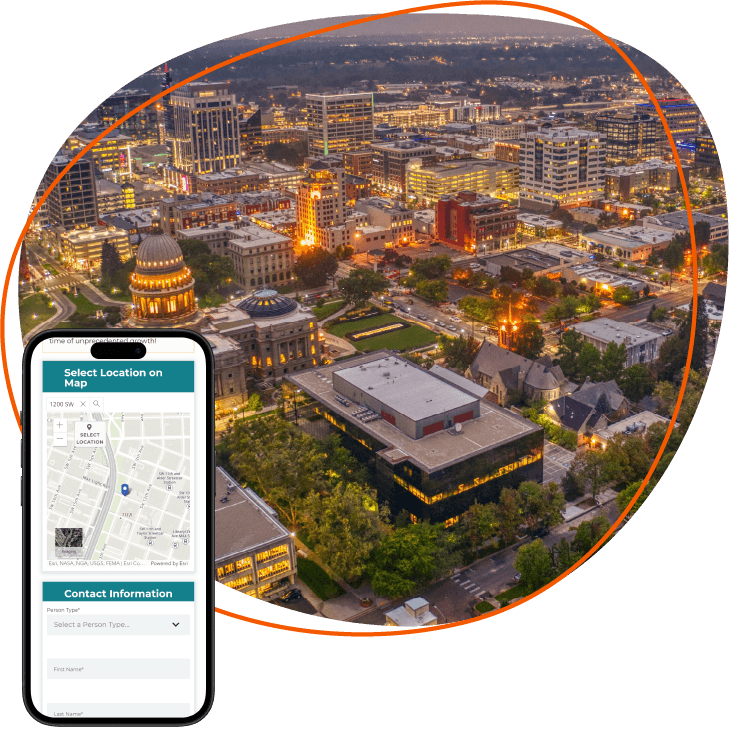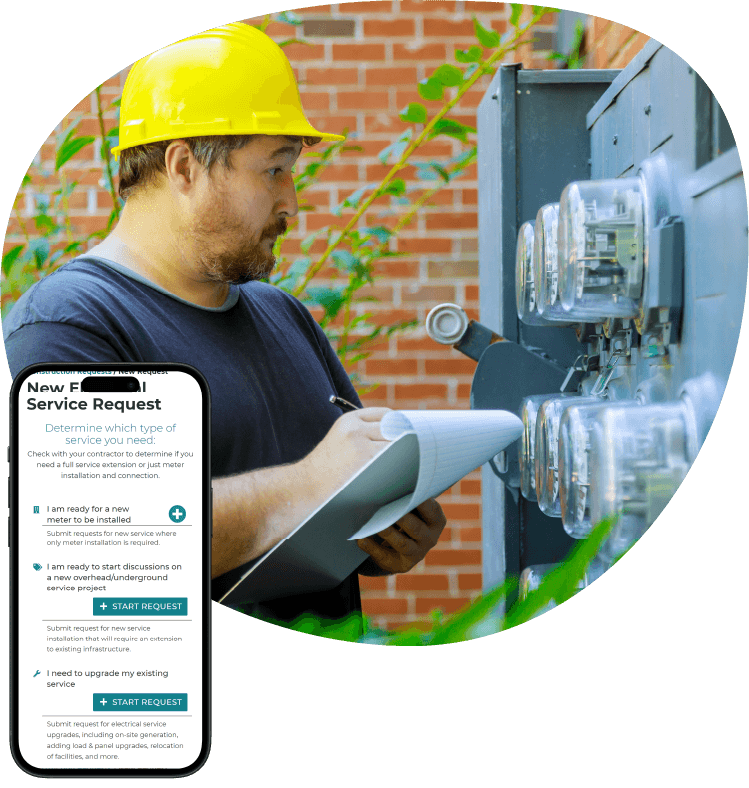
In Brief
New GIS-enabled web app and systems integration boost project coordination
A major energy company faced challenges in processing service requests from utility customers due to a cumbersome system of manual submissions and spreadsheets. Resource Data collaborated with the utility to create online request forms with GIS components and then integrated systems across departments, making it easier to submit and process requests.
This new system automatically channels information into a workflow for construction teams, leading to significant time savings, better document management, and improved interdepartmental coordination.
Key Takeaways
Efficient project coordination with GIS and integrations
-
New web app for significant time savings
Staff are freed from the time-consuming and error-prone process of collecting information by email, phone, or paper and manually entering it into a spreadsheet.
-
Seamless data flow for better project visibility
New integrations connect information for work orders to at least six departments, improving project coordination and reducing costly mistakes.
-
Centralized workflows for easier processing
With the forms automatically funneling information into workflows, requests are processed faster, and statuses are visible to all teams.
-
Online forms for greater customer satisfaction
Customers can now submit requests for electrical service upgrades through a straightforward online form. A unique ticket number makes it easier to respond to customer requests with greater speed and accuracy.

The Challenges
Manual processes cause bottlenecks and frustration
This leading electric utility serves more than 630,000 customers across two states. Customers and staff submitted requests for new electrical services, projects, and upgrades on handwritten forms and through phone calls. Utility staff then entered the information into a spreadsheet for tracking and processing the power line extension requests.
This workflow required a lot of back and forth between departments for permits, plan approvals, and more, leading to slower response times, extra manual data entry, and higher likelihood of errors. With an expanding service area, the utility needed a software solution to process these requests and to set up and track service-extension project work between departments.

The Solution
GIS web app simplifies service extension process
To streamline request processing, our team built a web application that manages the entire powerline extension request process. The app integrates with other systems, such as SAP enterprise resource planning software (ERP), Asset Suite asset management software, and AutoCAD Utility Design (AUD). With these integrations, service extension information is automatically turned into work orders for the utility staff to execute requests faster.
A centralized workflow within the utility’s construction application, allows staff to easily track project status, notes, and history. The system includes automated notifications and ticket identification numbers, making it easier than ever to coordinate across the multiple departments and to communicate effectively with customers regarding the status of their requests.
Features
Centralized workflow for better information management
-
Map features for accurate data collection
The online service extension request form allows applicants to drop pins on a map to show the location of the requested service area accurately.
-
Automated functions for streamlined operations
Staff receive notifications when the extension application is at specific steps. Ticket numbers are automatically assigned, making work orders simpler to track.
-
Centralized workflow to access and share data
The web app allows staff across multiple departments to check request and project statuses, history logs, notes, and notifications.
-
GIS-connected data for easier decision-making
GIS and other data are entered automatically into a workflow for the construction team to design how power lines run, provide estimates, and provide decisions on projects.
-
Connected systems for better information management
Integrated systems connect in ERP SAP and facilitate design in AutoCAD Utility Design (AUD). With everything in sync, it’s easy to track, manage, and retrieve information, preventing costly errors.
Results
Positive cross-departmental and customer impact
The new web app with built-in GIS tools makes it easier for customers to submit requests for electrical service for a variety of purposes—from new meter installation to upgrading existing service. The enhanced workflow led to significant time savings for utility staff while ensuring consistent data when setting up projects.
Because multiple departments now have access to the same information across their different software and tools, requests are processed faster. And costly mistakes—like double-ordering equipment, creating duplicate work orders, and having two designers working on the same project—are prevented. This has improved interdepartmental project coordination immensely, as well as customer satisfaction.
“This project transformed how our client handles service requests. By moving submissions online and integrating GIS capabilities, we’ve reduced processing time dramatically, allowing the utility’s teams to focus on delivering timely service to their customers instead of navigating manual workflows.”
Joel Florendo, Technical Lead

What's Next
Ongoing partnership
The positive results have led to more work integrating the client’s systems. We’ve also upgraded their outage map system to include additional alert types for planned safey outages and developed a portal to communicate wildfire risk levels to contract crews working on electrical equipment. We continue to support the utility in enhancing their technology and processes so they can focus on safely delivering reliable energy to the communities they serve.





